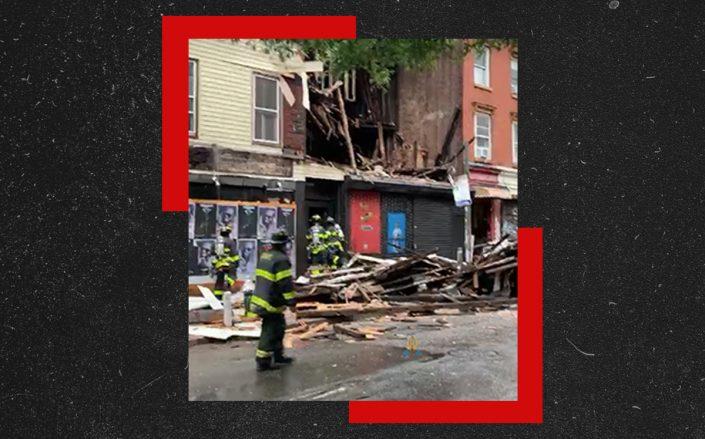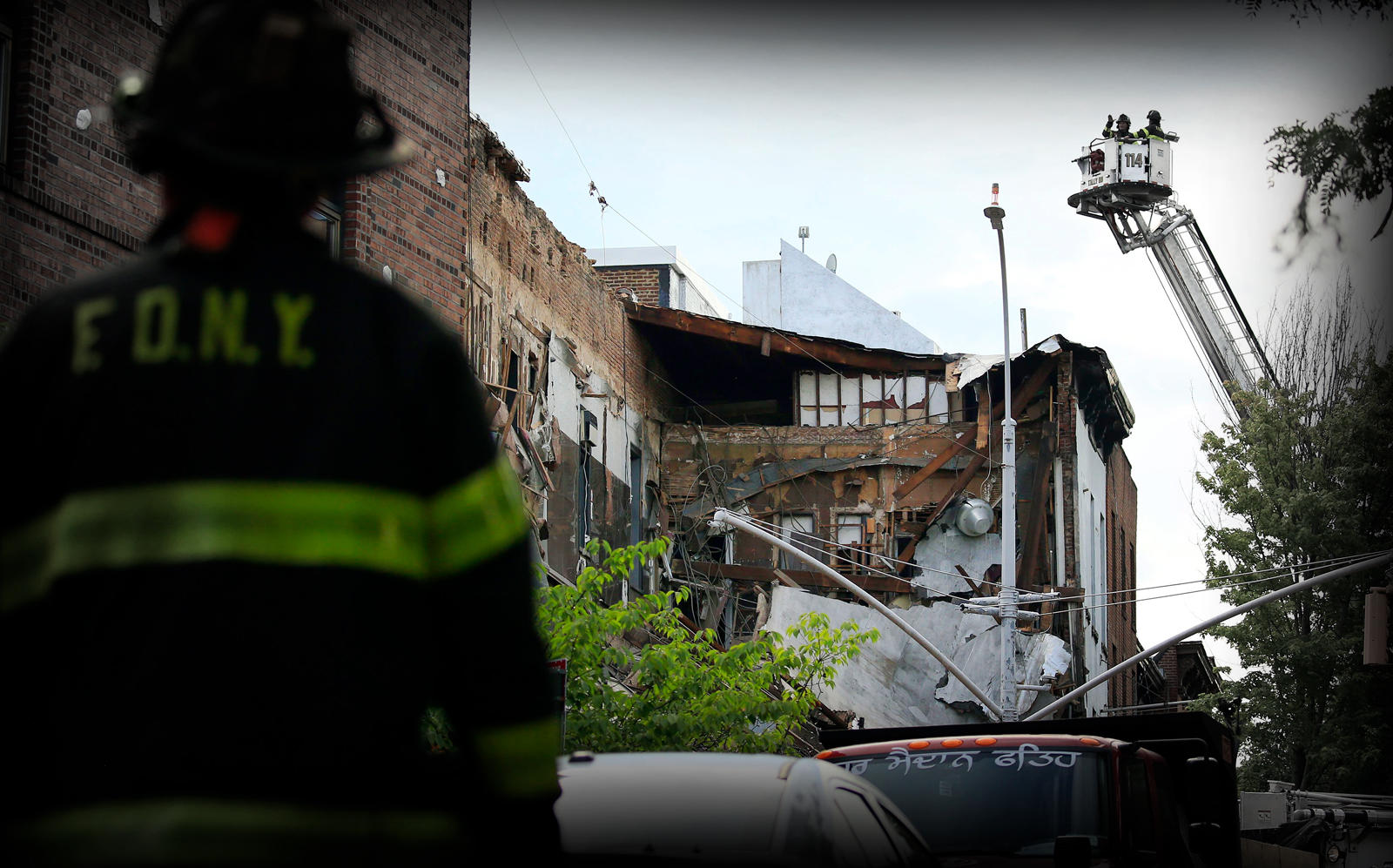Weeks before what would have been her younger sister’s 59th birthday, Lori E. Gold was unsettled by reports of crumbling buildings in New York City. Such news is disquieting for most, but for Gold, the reports have a personal sting: Her sister Grace, then 17, was killed in 1979 by a chunk of masonry that fell from an 12-story building on Broadway and West 115th Street.
“It is unnerving. It’s mind-blowing,” she said.
Last month, at least four partial or full building collapses occurred in the city. In a fifth incident, suspended scaffolding fell from a 12-story Midtown building and killed a construction worker who was fixing the building’s facade, which had been declared unsafe the previous year. This month two buildings on Bedford Avenue in Brooklyn partially crumbled, and wind ripped synthetic stucco cladding from a property in the East Village.
The causes of most of these incidents are still under investigation, but six of the buildings involved were not required to undergo periodic facade inspections. A 1980 city law prompted by Grace Gold’s death mandates buildings taller than six stories be inspected every five years. Shorter properties remain exempt.
“The discussion ever since 1980 has been, the buildings you excluded tend to be the oldest buildings in the city,” said Stephen Varone, president and founder of Rand Engineering and Architecture. “With every collapse, it becomes more obvious that some sort of increased vigilance has to be done.”
After architect Erica Tishman was killed last year by a piece of terra cotta that fell from 729 Seventh Avenue in Midtown, the city ramped up rules around facade inspections. Among other changes, the Department of Buildings hiked penalties, mandated additional close-up inspections of exterior walls and increased the required qualifications and responsibilities of inspectors.
This heightened enforcement, however, only applied to properties that fall under the city’s Facade Inspection and Safety Program, or FISP — in other words, taller than six stories.
The Department of Buildings says that does not let others off the hook.
“Our message to building owners is clear: It doesn’t matter how tall your building is, if it is located in the five boroughs we expect you to properly maintain it in a safe condition,” Andrew Rudansky, an agency spokesperson, said in a statement. “For building owners who don’t take that responsibility seriously, they can expect stern legal repercussions.”
But the string of recent incidents highlights the regulatory gaps in ensuring that shorter buildings — which number close to 1 million — are properly maintained. While owners of all buildings can be penalized for neglecting them, some public officials and industry experts feel the city needs to be more proactive in going after bad actors.
“When Grace died, the word around the city was that instead of looking down when you walked, for the first time everyone was looking up,” Gold said. “After Erica Tishman died, and I imagine right now as well, people are saying they are looking up. People are scared. And there are so many things to be scared about right now.”
Reading the signs
For several years, Norman Weiss warily kept an eye on a crack that spanned several stories of a building next to his home.
“I didn’t like to walk on that side of the street, because I know a little too much about these things,” said Weiss, a professor at Columbia University’s Graduate School of Architecture and specialist in building science and preservation technologies. Eventually, the owner erected a sidewalk shed, which stood for three years before repairs were complete, Weiss said.
A building’s deterioration is progressive, but when signs of decline are ignored, the results can be calamitous.

204 Bedford Avenue (Citizen App, iStock)
On July 1 at 348 Court Street in Brooklyn, a three-story gym — closed for the pandemic — collapsed, and a worker inside miraculously escaped with minor injuries. Multiple violations had been issued over the past few years against owner Union & Court Realty Corp., an entity tied to Kihyo Park, by the Department of Buildings. In June the agency issued a partial stop-work order after inspectors found three construction workers removing a large section of cement stucco from the exterior side wall without permits, according to officials. At the time, a violation issued by the agency noted that a brick wall was “dangerously bulging” over the sidewalk.
In fact, the agency had received complaints dating back to 2006 that the property looked unstable.
Several factors can contribute to a property’s decline, including age, location, building material and the installation of that material. Daniel Allen of CTA Architects said New York has the “perfect climate for making buildings deteriorate.” It is surrounded by saltwater and sees dramatic fluctuations in temperature, which can cause materials to weaken over time, he said. Faulty construction can also play a part. In a few of the cases last month, the DOB is investigating whether unsafe construction contributed to collapses.
But sometimes, owners are faulted. Such was the case at 205 East 38th Street, where a five-story, century-old parking garage partially collapsed July 8. According to the Department of Buildings, owner Antarctica Infrastructure Partners failed to properly maintain the brick facade. The agency ordered the owner to install a sidewalk shed and hire an engineer to study the property’s stability.
Owners of buildings taller than six stories face monthly fees for failing to file facade inspection reports and fines for failing to correct unsafe conditions. Owners of shorter buildings aren’t subject to late-filing penalties, but can be fined $1,000 to $25,000 for failing to maintain their properties in a “code-compliant manner.” Antarctica Infrastructure Partners was hit with a $6,250 fine for that reason, according to the Department of Buildings.
But Varone said without the framework of the city’s facade program — and regularly scheduled inspections by licensed experts — the “code-compliant” mandate can seem amorphous to owners of smaller buildings. It can also be easier to ignore, until something goes wrong.
“Sometimes owners need a little bit of prodding or a little bit of structure for what it means to keep your building in good condition,” Varone said. “It’s like saying, ‘Keep your roof in good condition.’ OK, but what does that mean?”
“If you give a laundry list of what to do to keep your roof in good condition, that goes a long way,’” he said.
Possible fixes
The city oversees more than 14,500 buildings as part of its facade safety program. Though the agency doubled its facade inspectors last year, it still has just 22, and adding shorter buildings to the program would require a dramatic increase. An estimated 980,000 properties fall into that height category.
“To me, the Buildings Department is too hopelessly understaffed to deal with what happens in the city,” Weiss said. “The paperwork that is submitted by every building that is greater than six stories is so enormous, you ask yourself, is it really reviewed by people?”
Rudansky, the agency spokesperson, said every filing is audited and the department has the resources to hold bad actors accountable.
Midtown Council member Ben Kallos said the agency has “conflicting mandates,” as it is charged with both enabling and policing construction in the city.
“Their primary mandate is to build. It’s in their name,” Kallos said. “We get far more complaints [about the agency’s red tape] from people trying to open up a new school, trying to open up a new commercial space. That’s where they feel the most pressure.”
Rudansky said his agency has streamlined the development process but noted, “We do not make policy decisions that diminish safety in favor of expedience.”
Kallos favors shifting enforcement to the Department of Housing Preservation and Development. He said requiring inspections for shorter buildings would be a step in the right direction, but he suspects this hasn’t been done out of fear of “overburdening landlords.” Such a change would require legislation, which in New York City does not require a cost-benefit analysis.
Safety enhancements can be expensive for owners, who would be on the hook for paying licensed experts to perform inspections and install sidewalk sheds if the property is deemed unsafe. The Real Estate Board of New York indicated that it would be open to expanding facade regulations if analysis justifies it.
“REBNY supports policy responses that use data and take advantage of new technology to keep the public safe,” said James Whelan, president of the trade group, which has supported the use of drone technology for facade inspections.
Acknowledging that such a rule would likely benefit his own business, Varone said the city could mandate that owners of shorter buildings get professional inspections every few years — without requiring their reports to be sent in. Rather, owners would keep them on hand and produce them upon request or be heavily fined. This would enhance safety without overwhelming the city with paperwork.
“If something falls from the fourth story of a seven-story building, it’ll kill you. If it falls from the fourth floor [of a smaller building], it hurts just as much,” he said. “At some point something’s got to happen.”
Write to Kathryn Brenzel at kathryn@therealdeal.com
Correction: Due to an editorial error, Grace’s Gold age in 1979 was misstated. She was 17.
